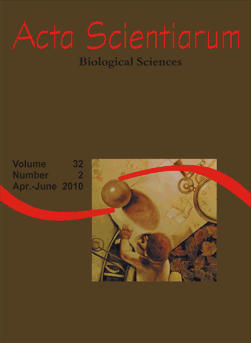<b>Molecular heterogeneity of <em>Malassezia pachydermatis </em>through RAPD-PCR</b> - doi: 10.4025/actascibiolsci.v32i2.4788
Resumo
Several methodologies in molecular biology have been used in the investigation of Malassezia pachydermatis and its differentiation into subtypes. Recent molecular research of this species includes the use of samples isolated from canine otitis externa and dermatitis, as well as from healthy animals, having in view an epidemiological study of the yeast. The aim of this study was to identify molecular differences in M. pachydermatis samples isolated from dogs with otitis externa. The M. pachydermatis strains were analyzed by means of the Random Amplification Primer DNA - Polimerase Chain Reaction (RAPD–PCR) for molecular heterogeneity research. DNA extraction was carried out with phenol-chloroform and the RAPD technique using the AGAATCCGCC primer. A variation was observed in the number and arrangement of the bands among the 49 studied isolates, grouped into nine patterns. Isolate groupings were not found to be related to animal breed, age or sex. It was concluded that M. pachydermatis has differences in its molecular profile, as shown by the molecular technique (RAPD – PCR), which allows isolates to be classified into nine subtypes.Downloads
DECLARAÇÃO DE ORIGINALIDADE E DIREITOS AUTORAIS
Declaro que o presente artigo é original, não tendo sido submetido à publicação em qualquer outro periódico nacional ou internacional, quer seja em parte ou em sua totalidade.
Os direitos autorais pertencem exclusivamente aos autores. Os direitos de licenciamento utilizados pelo periódico é a licença Creative Commons Attribution 4.0 (CC BY 4.0): são permitidos o compartilhamento (cópia e distribuição do material em qualqer meio ou formato) e adaptação (remix, transformação e criação de material a partir do conteúdo assim licenciado para quaisquer fins, inclusive comerciais.
Recomenda-se a leitura desse link para maiores informações sobre o tema: fornecimento de créditos e referências de forma correta, entre outros detalhes cruciais para uso adequado do material licenciado.












1.png)




3.png)













